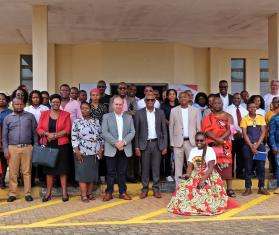From DNDi - Drugs for Neglected Diseases initiative
Geneva/Kampala, September 22, 2009 - NECT (Nifurtimox-Eflornithine Combination Therapy), the first new treatment in 25 years against Human African trypanosomiasis (HAT) or sleeping sickness, is now available. Endemic countries have now begun the process of ordering the new combination treatment and kits through the World Health Organization (WHO). Developed by DNDi and its partners, NECT cuts the cost of treatment by half and significantly reduces the burden on health workers. The announcement was made today at the International Scientific Council for Trypanosomiasi Research and Control (ISCTRC), in Kampala, Uganda.
Geneva/Kampala, September 22, 2009 - NECT (Nifurtimox-Eflornithine Combination Therapy), the first new treatment in 25 years against Human African trypanosomiasis (HAT) or sleeping sickness, is now available. Endemic countries have now begun the process of ordering the new combination treatment and kits through the World Health Organization (WHO). Developed by DNDi and its partners, NECT cuts the cost of treatment by half and significantly reduces the burden on health workers. The announcement was made today at the International Scientific Council for Trypanosomiasi Research and Control (ISCTRC), in Kampala, Uganda.
“Thanks to an innovative partnership and the hard work of health workers, researchers, and specialists from endemic countries, industry and academia, a new treatment is now available to treat one of the most neglected disease in Africa. Not only is this new therapy more adapted to patient needs in remote areas, but it also cuts the cost of drugs, hospitalization and transport,” said Dr Bernard Pécoul, Executive Director of Drugs for Neglected Diseases (DNDi).
Sleeping sickness threatens 60 million people in 36 countries across sub-Saharan Africa. Transmitted to humans by the tsetse fly, this neglected tropical disease is fatal without treatment. NECT is a new, combination treatment option for the advanced stage (stage 2) of HAT or sleeping sickness. This stage affects the patient’s central nervous system and causes neuropsychiatric problems, convulsions, and serious sleep disturbance—leading to coma and death.
In May 2009, NECT was added to the WHO list of Essential Medicines for the treatment of sleeping sickness.
NECT combination therapy consists of a simplified co-administration of oral nifurtimox, and injectible eflornithine. It reduces the total number of intravenous infusions of eflornithine from 56 to 14 and shortens hospitalization from 14 days to ten, which makes treatment more convenient for patients. Because NECT only requires two infusions a day, administered during the daytime, this is easier for health workers and makes treatment far more suitable for remote and resource-poor settings where HAT is being treated.
Until now, health workers and patients had two main treatment options: 1) widely used ‘melarsoprol’, which is painful to inject, arsenic-based and toxic, and kills an estimated five percent of patients, and 2) the newer Eflornithine monotherapy, which requires one hour infusions, to be given every six hours for two weeks. Eflornithine monotherapy is better tolerated and more effective than Melarsoprol, but due to the high burden on health workers and the high cost of the medical equipment required to correctly administer it night and day, too many patients throughout Africa still continue to be treated with toxic Melarsoprol.
“As a doctor, you don’t treat someone to see them die, you treat them to see them go home,” said Dr. Constantin Miaka Bilenge, National Health Advisor, for DRC. “This new combination treatment is easier to use than eflornithine in monotherapy and brings hope for the patient and for the clinician, especially in countries like ours where the infrastructure has broken down.”
Treating patients with the new combination therapy now costs half as much as the existing, eflornithine monotherapy. With the NECT kits, the cost per patient of medicines, medical treatment and transport is halved to US$330 from US$665 for ‘eflornithine monotherapy’. Because the new treatment reduces the number of daily intravenous infusions and the length of treatment, it also reduces the cost of hospitalization and the burden on health staff in country.
“The availability of NECT improves the treatment of sleeping sickness and makes a big difference in terms of logistics, hospitalization, and cost,” said Dr Pere Simarro, Head of WHO sleeping sickness control and surveillance program."To support countries, WHO will make available, free of charge, kits which include the new treatment and all the medical equipment needed to treat patients in remote areas.”
WHO has made preparations for the arrival of NECT and is working to ensure health workers receive appropriate training. WHO has designed a kit in collaboration with Médecins Sans Frontières-Logistique that contains the medicine and all the equipment needed to correctly administer the treatment.
The kits are provided to countries free of charge through WHO1. It is hoped this will also help national control programs to switch from toxic and painful Melarsoprol to better tolerated NECT.
Jacqueline Tong, senior advocacy officer for Doctors Without Borders/Médecins Sans Frontières (MSF) added: “Until now, we have been losing patients because of toxic old drugs such as Melarsoprol, so we welcome and urgently need this new, safer and less complicated treatment to save lives from this fatal disease.”
Each 36 kg NECT kit contains four full treatments instead of two treatments with the eflornithine monotherapy. The volume per treatment is also reduced from three cubic feet to 1.3. Less volume and less weight makes transport much easier and cheaper, especially to remote areas in places such as the DRC.
The development of NECT is the result of a six year collaborative partnership, coordinated by DNDi. Partners include, MSF, Epicentre, HAT platform, the Swiss Tropical Institute, the national control programs from Democratic Republic of the Congo (DRC) and Republic of Congo, with the support of the WHO. The drugs were donated by sanofi-aventis and Bayer Schering Pharma AG.
The Drugs for Neglected Diseases initiative (DNDi) is an independent, not-for-profit product development partnership working to research and develop new and improved treatments for neglected diseases such as malaria, leishmaniasis, human African trypanosomiasis, and Chagas disease. With the objective to address unmet patient needs for these diseases, DNDi was established in 2003 by Institut Pasteur and Médecins Sans Frontières along with four publicly-funded research organizations in neglected disease-endemic countries. Working in partnership with industry and academia, DNDi has the largest ever R&D portfolio for the kinetoplastid diseases and currently has 3 post-registration, 9 clinical, and 4 preclinical projects, along with a wide variety of discovery activities. In 2007 and 2008, DNDi has delivered its first two products, fixed-dose antimalarial “ASAQ” and “ASMQ”. This year, the safe and effective treatment for the advanced stage of sleeping sickness NECT (nifurtimox-eflornithine combination therapy), has been added to the Essential Medicines List (EML) of the World Health Organization. For further information, please consult www.dndi.org.
- Since the beginning of the 20th century, medicines and treatment for sleeping sickness, TB and leprosy have traditionally always been provided for free to patients throughout Africa. Because sleeping sickness affects the poorest of the poor and requires hospitalization, treatment cannot be purchased over the counter and is managed through specialized national control programmes.



